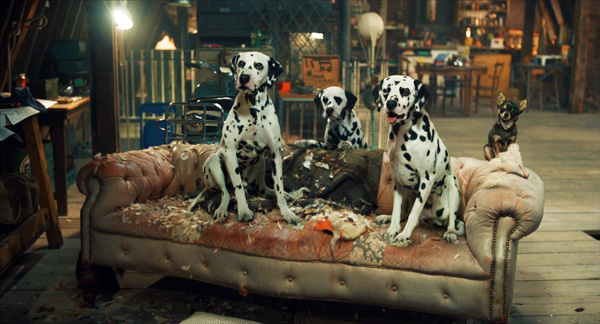
The Disney movie ‘Cruella’ introduces the world to the vengeful young fashion designer Cruella de Vil, descending on 1970s London as the punk rock years rolled in. The VFX work on the movie began during pre-production, about three months before principle photography got underway in May 2019. Given the large number of shots ‘Cruella’ required, over 1800 in total, that lead-up time was short. Of the total, MPC completed 1165 shots, which included 2D and 3D environmental work, complex set extensions, FX and building and animating seven photoreal dogs.
MPC's work on 'Cruella' is selected as a finalist in the AEAF Awards Feature Fim VFX category.
For Production VFX Supervisor Max Wood, who talked with Digital Media World about the project, the production involved an unusually high number of shoot locations in and around London, at times more than one in a day, while he worked on set with a large crew. Supporting him was MPC’s internal VFX Supervisor Damien Stumpf and VFX Producer Sarah Tulloch.
To make the environment work run efficiently and look coherent, MPC collaborated with two Art Departments at different stages. “The majority of concept work came from the art department team working with Production Designer Fiona Crombie,” said Max. “They were great to work with through pre-production. Then, once we got into post and needed further art work, we called on the Technicolor Art Department, who produced other concepts such as the 1970s London skylines from photo reference.”
If possible, everything at the set locations was scanned, and meanwhile the team was also collecting camera data, HDRIs and copious reference photography, scouting on foot.
Girl’s Best Friend
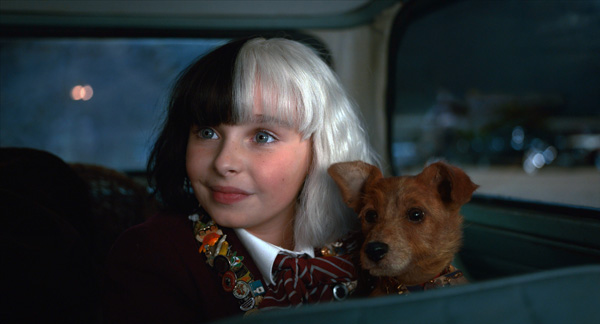
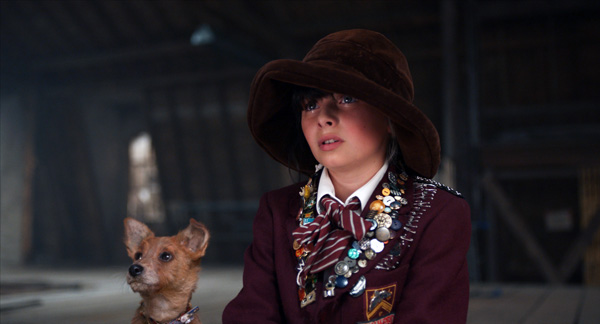
Dogs are a major feature of Cruella’s story. One of them is her best friend, another is a con artist and the Dalmatians are villains. The production had real dogs performing on set, but because they needed to be consistent enough to develop personalities, and perform very specific stunts, MPC built and animated them in CG as well. The edit would often cut between the digital and live action versions, which meant the team had to re-create them to an extreme level of detail. They went through a thorough R&D stage before settling on the best approaches.
The first task was capturing enough data. “We took photogrammetry scans of the dogs several times through the shoot, which was especially useful for the puppies as they were growing so fast throughout production. We hired a company called Clear Angle Studios for the photogrammetry, as I've worked with them several times and love the quality of their work.
“They had a rig set-up inside a capture room with over 180 cameras that fire and flash simultaneously. To acclimatise the dogs to the sounds and flashes we would sit them outside of the room to begin and fire off a few test flashes to see how the dogs reacted to the noise. As long as they were comfortable, we would take them into the room and fire some more shots.
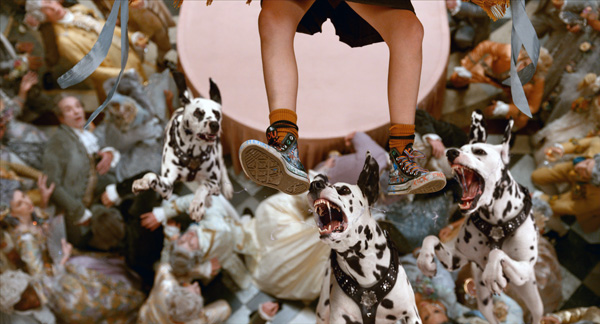
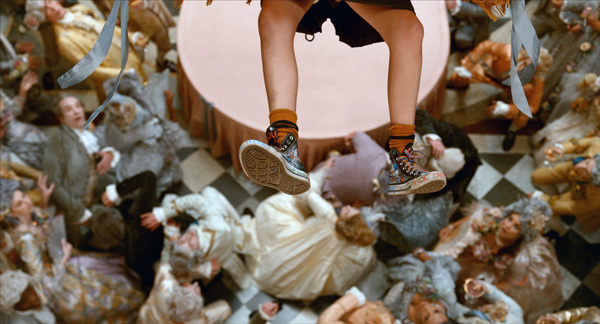
“The trainers would put them onto a box in the centre of the rig and stay there with them, while trying not to block the cameras, getting them to pose and maintain a good eyeline. We captured several poses, sitting, standing, mouth open and so on. It was really important for the dogs to be relaxed, as the scan forms the base of our model and muscle system. If they are tense at this stage, it can get baked into our neutral shape.
“Once we had several takes of each dog, Clear Angle sent us contact sheets of the captures and from those, we decided which ones we needed. Their team then processed and delivered them to us as geometry.”
Light and Scale
Building the dogs was one undertaking – compositing them invisibly into shots was another. Light and scale were going to be critical factors. Using the same photogrammetry data, stand-in versions of the dogs were 3D printed to scale.
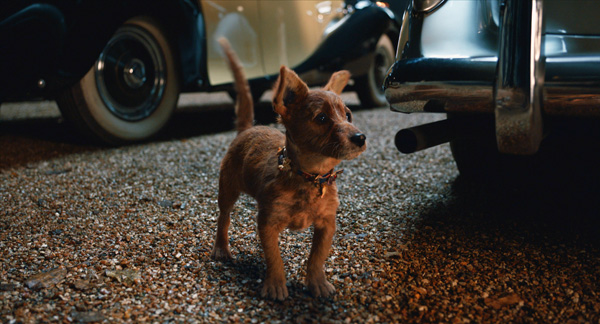
Cruella's friend Buddy as a puppy...
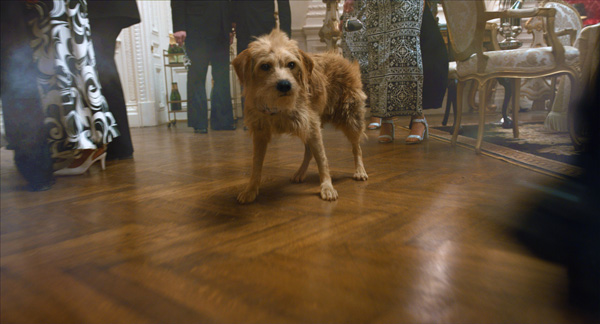
...and all grown up.
“Once we received the first scan of each dog, we built a quick model from that scan and sent it to a 3D printer to create a life size ‘print’ of the dog, and sprayed it in the same grey paint as the grey balls we use for onset lighting reference. During the shoot, we shot a reference plate of the grey dogs for the lighting department to use later in post, which was also handy for the camera department to use for framing on the dogs that we would add later,” said Max.
“As well as the grey 3D prints, we worked with a company called Animated Extras to create life size articulated rubber versions of each dog that were weighted for the actors to interact with. These rubber dogs were especially useful for scenes like the one when young Estella is running with a CG version of Buddy, her puppy, under her arm.”
Dogs in Motion
In pre-production ahead of the shoot, Animation Supervisor Dan Blacker and the animation team prepared to bring the CG dogs to life. The animators took the real dogs out for a reference shoot and let them run around naturally and be themselves. That gave them an authentic idea of how each one moved and served as valuable reference for the motion – steps, runs, jumps and even swimming – and also let them know how far they could ‘cheat’ the moves to match extreme demands from the story or the director Craig Gillespie.
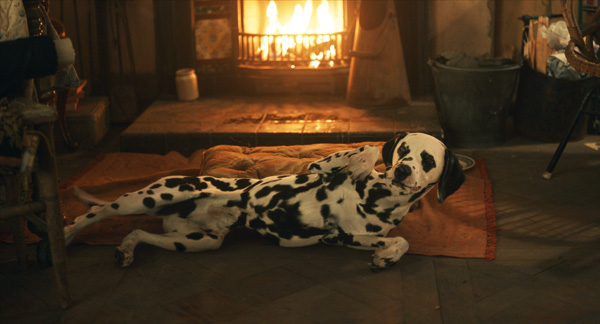
The edit includes lots of close-ups of the digital dogs, both faces and full body hero close-ups. The team also had to be prepared to make their CG dogs fit in anywhere and do almost anything, and often re-positioned them from what or where the live dog was performing on set. The live-action Dalmatians were fairly boisterous, which is typical for that breed, and a bit hard to control on set. They had to be replaced and animated in nearly all shots, about 100 in total, in their sequences.
The dogs’ fur was critical. The care taken to capture lighting reference on set was largely to support creating the fur. MPC’s in-house Furtility software was used but the shader first needed updating to accommodate the widely varied dog breeds. Wink the one-eyed chihuahua was the easiest in this respect, but Buddy’s wiry, tufty terrier’s fur was problematic, not least because the puppy (actually a female) they had on set for Buddy’s early years was growing up and changing rapidly as the weeks passed.
Managing Change
London has actually changed considerably since the era of this story, particularly in the areas around the River Thames where many scenes take place. A number of new landmark buildings have been constructed, the railways have been modernised – all of which had to be removed or replaced, or both – and lighting and colours are brighter now. They were able to source plenty of contemporary aerial footage to help grasp the nature of the historical changes, and found other footage online and from the BBC’s archives.
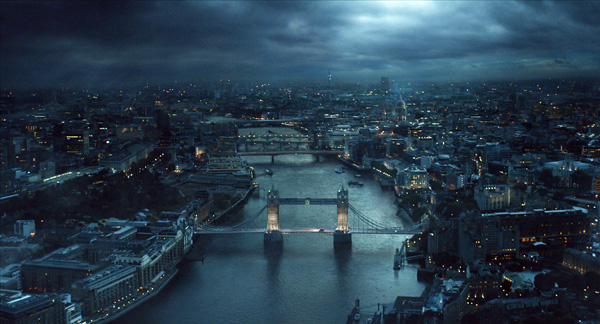
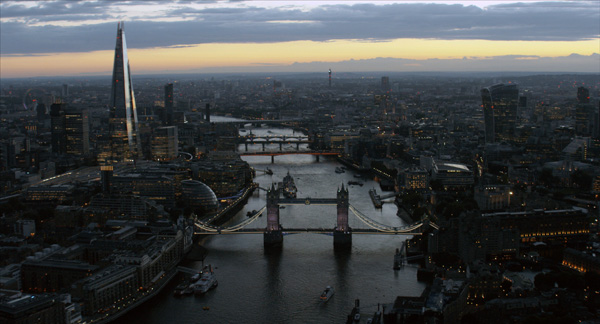
To manage the many elements that had to be re-introduced into street scenes, like busses, taxi ranks, call boxes and road markers, they built a huge library of contemporary assets and colour reference. Ahead of the shoot, the production closed streets at set locations but as this wasn’t always an option, MPC still had to replace many cars with period vehicles as well.
Liberty of London
A turning point in Cruella’s life was going to work at the famous department store, Liberty of London, which still operates in the middle of the city. To visualise for the audience what the store was like in the story, from outside in and top to bottom, MPC created an engaging single shot, lasting one-and-a-half minutes and composed mostly of CG elements. The shot starts in front outside over the street, moves up over the building, drops smoothly through Liberty’s lovely glass roof and starts its descent through the central atrium.
It was based on seven plates of the existing location. Max said, “To capture the plates, we shot the live-action exterior on a drone, then descended through Liberty’s atrium on a cable rig. Then, when we get to the ground floor, we moved the camera onto a steady cam, followed by transitions to several handheld gimbal rig plates ending up in the basement where we catch up with Cruella.
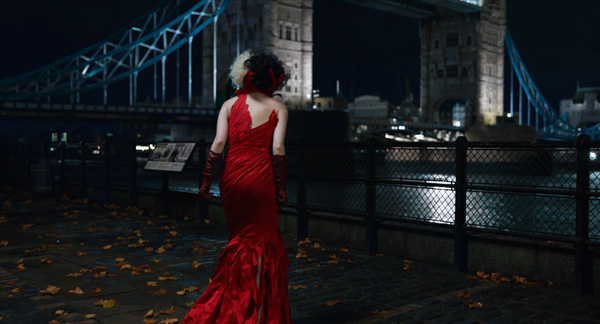

“In post, after the drone shot of the exterior, the glass roof and the upper four interior stories of the Liberty store were re-constructed digitally. The shop floors were filled with CG period fashion merchandise, shop decorations and people – with a few elements of live-action actors added in. All of these various plates were then stitched together using wipes or CG extensions to create the look of a long camera move.”
The whole shot was pre-vised carefully, especially for the wipe points they would use to stitch CG to real live action, which were critical for the director. “The work had to be very subtle and natural and not hidden behind devices like opening doors or props,” said Max. “He wanted a very smooth flowing shot from top to bottom.”
Hellman Hall
The building and grounds where sequences featuring the Baroness’ mansion Hellman Hall were shot was quite different from the setting the director had in mind. His vision was of a larger, more imposing manor house, symmetrically designed. He imagined the grounds out in a remote location, extending to a cliff edge above the sea. MPC removed numerous trees and a deer park from the shots to make it feel wilder and more remote, and added the distinctive gates, the cliffs and smashing waves.
“In some shots the majority of the house is digital, especially when we see it from the front. But when we see it from the cliff edge, the lower two levels of the house are live action and we replaced the top of the house. The rear of the house is always CG because a tree was covering a large part of it. Craig was very insistent that we removed all of the trees,” Max said.
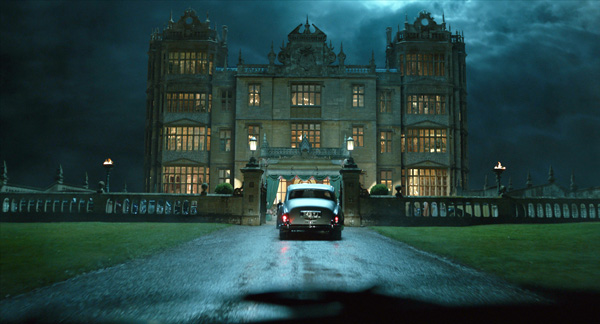
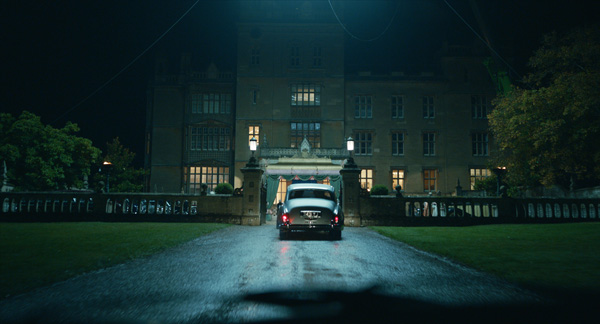
“To extend and adapt the house to make these changes, we needed a lot of reference of the real building. Not only did we lidar the house but also took a lot of reference photography both from the ground and from a drone to make sure that we had all angles covered. Once the art department had produced a design of the house, making it far grander and one story taller, we then found reference of other English stately homes that we could build the roof and the ornamental detail from, matching the concept.”
The interior of the rooms we see through the windows are simple 3D models based on on-set photography. In fact, the sets of the interiors where the Baroness’ over-the-top parties take place were fairly complete – the team only needed to create a few views from windows and through doorways, and extend some ceilings upwards to accommodate the action.
Not Quite Over...
The fiery sequence at Hellman Hall, when the villains attempt to kill Cruella, involved two shots, starting from the ground level and then up into the digital section, and then stitching these together to make one continuous pan. The team then composited in flames to the right level of fierceness and added interactive lighting to the CG, with London off in the distance as the background.
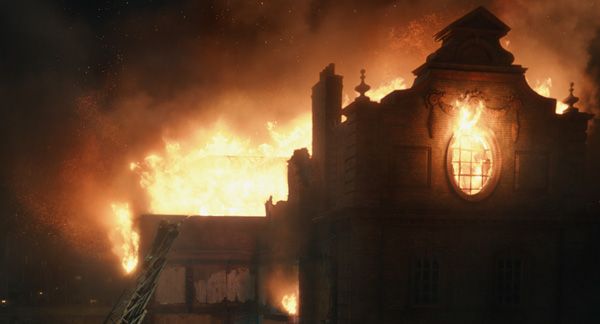
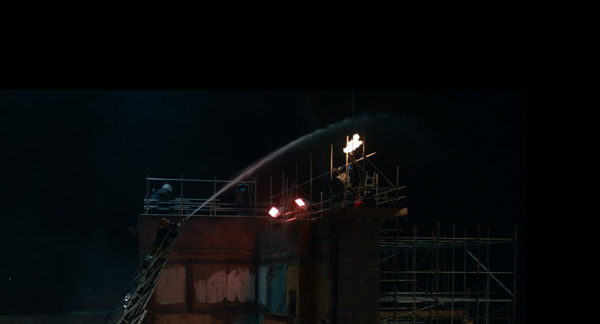
The end of the film brought one more challenge that the Technicolor Art Department helped them tackle. “Our biggest challenge here was re-designing the parachute for the end of the movie,” said Max. “For the artwork, Craig gave us a sketch of its silhouette and the Technicolor team worked it up. It took a few iterations to really get to a design where it looked cool and that Craig was happy with, but also looked like it would actually work as a real parachute!”
Fashionista
Cruella’s haute couture dresses – her reason for living and her best weapon against her rival, the Baroness – were a challenge because each one was different and had to be handled in a completely different way from the ground up. Some involved real elements that Cruella actually wore, and others were all digital.
For example, the spectacular dress completely covered in moth chrysalises, which burst open and release tens of thousands of moths at one of the Baroness’ fashion events, was never actually a real dress. To fully understand how such a dress would look – in-camera, in action and fully lit – Max and the MPC team built some practical chrysalis elements and stitched them to a fabric sample. This sample was then shot at several angles on set under the correct lighting.
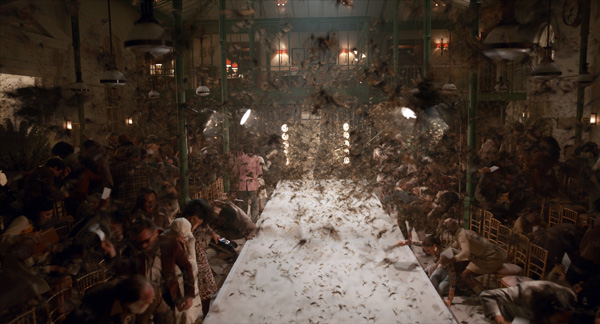
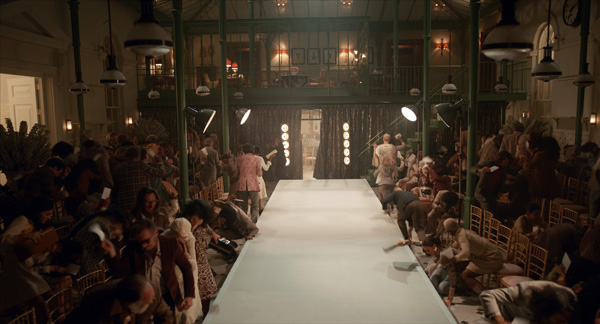
“It was important for the director to be able to control the distinctive, iridescent look of the chrysalises and make sure that quality came across to viewers at every moment. We created a handful of individual chrysalis variations, plus the destroyed ones for the shot after the release, and then used Houdini to lay them out on a pattern that had been given to us by the costume department. It took us about 40 to 50 hours per frame to render,” he said.
“Once the moths emerge, we used Houdini to orchestrate their path. It gave us great flexibility in determining their path, speed and density, as it was difficult to get the balance just right and took many, many iterations to really get a feel that Craig was happy with. He wanted some to fly close to camera for excitement, but also to keep a random, natural look.
Fashion in Flames
For the sequence featuring a flaming cloak, Cruella’s real performance was captured with the actress in her red dress. Max said, “From this footage, we roto animated Cruella so that we knew exactly how she moved and could place her white cape in the correct position in 3D space on each frame. Once it was in exactly the correct place, we could create our cloth and fire simulations and know that it would match the plate of Cruella in the red dress.
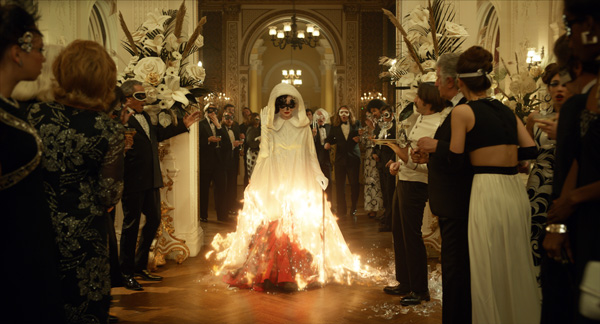
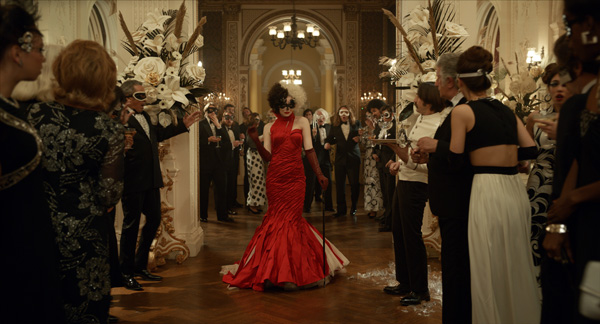
“We also filmed Cruella in her white cape, as well as the red dress, as a lighting and movement reference. That way, once we had our CG version we always had a live action version to reference to make sure that our version matched it in look and movement.
“One tricky part of this task was that Cruella's very springy, live-action hair is actually much bigger than the CG hood would allow for. If you look closely, you can see that we placed fire very carefully to act as a wipe and then animated the hair springing up bigger – behind the fire. The roto animation of the performance, combined with lots of smaller details like the hair, made this a tough scene.”
Disney’s ‘Cruella’ can be seen now on all major digital platforms, and on 4K Ultra HD, Blu-ray and DVD from 21 September. Viewers can watch special bonus footage and deleted scenes in Ultra HD quality and Dolby Atmos. www.mpcfilm.com


















